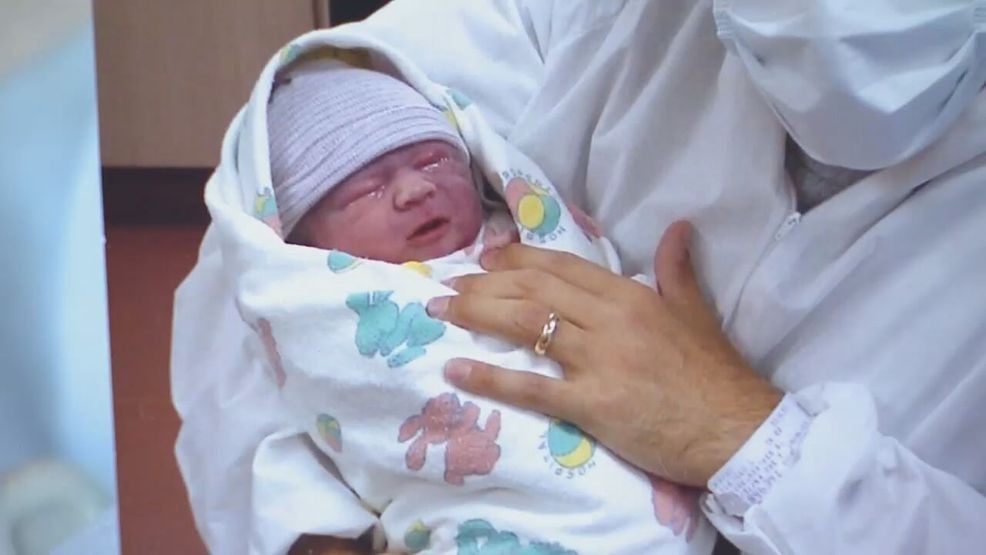SEATTLE — It is one of the most horrific tragedies for a parent: the sudden, unexplained death of a seemingly healthy baby.
Now, a leading researcher on Sudden Infant Death Syndrome (SIDS) says we are in a “breakthrough moment” when it comes to figuring out what causes some of those mysterious and heartbreaking deaths. And the science ties back to a local baby’s sudden death nearly 22 years ago.
This is Aaron.” Heather Kahan of Mercer Island shared one of the few photos of her son. “Just, probably a few minutes old, I think, in this photo.
Heather and John Kahan just published a book, with 100% of proceeds going to the Aaron Matthew SIDS Research Foundation and the World Wildlife Fund. Heather wrote the book, while John took the photos on their journeys around the world. They describe it as “a testament to the awe inspiring diversity of our planet, as seen through the eyes of infants – both human and animal.”
Aaron Kahan was the first boy in a family that included three big sisters. But the son Heather and John Kahan dreamed of stopped breathing just five hours after his birth. Aaron became one of the thousands of children to die every year with no known cause other than Sudden Infant Death Syndrome.
When the cause of death is labeled as SIDS, what that means is there’s no medical explanation at all for what happened,” Heather said. “And so you’re wondering even more about, oh my gosh, maybe we could have done something differently that would have taken us down a different path.
It is a question that carries guilt and deep sorrow. The Kahans turned their grief into action, creating the non-profit Aaron Matthew SIDS Research Guild that brought researchers from Seattle Children’s together with data scientists at Microsoft, where John worked at the time.
The team performed whole genome sequencing on 144 children who died sudden, unexplained deaths and recently discovered variants in eight genes that hadn’t previously been associated with SIDS. While the gene variants don’t inevitably lead to SIDS, they do signal a risk. And remarkably these variants are also seen in people who die other sudden deaths, including sudden cardiac arrest.
Every day, 1,000 people die of sudden cardiac arrest. Then you put in also the kids of SIDS that have similar mutation,” explained Dr. Nino Ramirez of Seattle Children’s Research Institute. “So now you think every year, half a million kids are born with some sort of a deadly mutation. Some will die in the first year. Others will survive, but then they become teenagers, and they do highly intense sports. Suddenly, they drop dead as athletes. Some will smoke, some will get obese, and some will have anorexia. All these different factors can now compound on this genetic vulnerability, and then they die suddenly.
When researchers performed the genome sequencing, they used tissue saved from SIDS babies. Among those analyzed and found to carry the risky gene mutations is Aaron Kahan. Decades after his death, his parents finally know for certain they did nothing wrong.
“It’s very freeing. I mean, I’m just so incredibly grateful to the scientists and the medical researchers who have just, their perseverance got us to this point,” Heather said. “And it’s a gift.”
It’s a gift to Aaron’s parents but an even greater gift to future children. Ramirez hopes doctors will eventually be able to screen infants with a prenatal or at-birth test that would reveal a higher risk of SIDS, so doctors could intervene .
“Twenty-five years of research is now transforming SIDS into a disorder, a clear, it’s like epilepsy, you know? It’s like cardiac death. There’s something defined that causes it,” he said.
Not all SIDS deaths can be attributed to the risky genes. However, an infant with the mutations will be particularly susceptible to other risk factors, like stomach sleeping or having a mother who smokes. Aaron’s life was much too short. But his legacy in unraveling SIDS is everlasting.
“Look how proud I am of my son. He was only here five hours, but look how many things he’s done in his life, which is incredible and not just for us, but for parents all over the world,” John said.
